Nancy Love: Bridging the Data Gap
This is an archived conversation with Nancy Love about using data effectively within your MSP project. This topic relates to the MSP key feature Evidence-Based Design and Outcomes.
Nancy Love is the author of Using Data/Getting Results: A Practical Guide to School Improvement in Mathematics and Science (2002, Christopher-Gordon Publishers, Inc.)
 |
My name is Nancy Love and I look forward to engaging with you around some critical issues related to using data to produce better results for kids. I can imagine that this is a central concern for your MSPs and I really look forward to hearing from you about your reactions, your suggestions about these critical issues. |
| |
|
 |
I've organized the presentation around a couple of questions. How can MSPs help to sustain effective use of local data and research to better serve students. And what are the building blocks that enable schools to use data to improve results. I'd love it if you leave the presentation feeling like you've got some discoveries about how to move toward more effective and collaborative and powerful uses of data in your own MSPs. |
| |
|
 |
Here's a problem that I see in a lot of schools and districts that I work with. Tell me if this resonates for you. Picture two shores. On one shore there's student learning results. That's our desire, our intention, our passion. and I think now our mandate, to do better for kids. And on the other shore, there are piles of data. There's enrollment data, there's achievement data, disaggregated data, there's attendance data, there's dropout rates, there's discipline referrals, surveys. The problem, as I see it, is that there's an ocean in between. That in many schools staff are not able to connect the data that they've got with the results that they want. What's missing is the bridge. So let's construct that bridge. |
| |
|
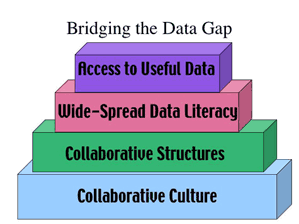 |
Here's what I see as the essential building blocks: A collaborative culture, collaborative structures, widespread data literacy, and access to useful data. So let's take a look at each of these in a little more depth. |
| |
|
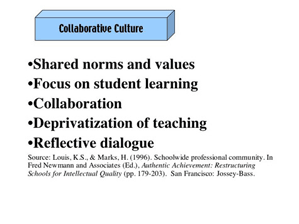 |
At the foundation, it's collaborative culture. Collaborative culture, in my mind, creates the container or the context in which staff can have powerful conversations about data, respond to those data in appropriate ways, and actually make a difference for kids. How do you know if the schools that you are working with have a collaborative culture or not? There are a few essential features that I think define what a collaborative culture is. This comes from the work of Karen Seashore Louis and her colleagues that looked at schools that were producing improvement for kids, and she found some common characteristics. The first was a sense of shared norms and values. These are the schools you know from the minute you walk in. You see a big mission statement over the office, and you see student work and folks are looking engaged and excited about teaching and learning. These are the places where the community is clear about what its values are and they are committed to acting consistently with those values. So the mission statement doesn't sit in a book somewhere that nobody looks at. They are also engaged in ongoing conversations about to what extent they are living up to their values. So the data become useful feedback for them. Are we the school that we want to be and what do we do to get better. A second feature of a collaborative culture is a relentless focus on student learning. One of the principals that I interviewed said, we don't talk about wilted lettuce any more. What we talk about is teaching and learning. So focus on student learning. Co-laboration, co-labor. Teachers working together to enact these values and to take responsibility for student learning. The fourth feature is the deprivitization of teaching. In schools that are producing results for kids, there is lots of conversation about teaching and learning. Teachers are outside of that isolation, they move out from behind the closed doors, and they talk about teaching as a public act. The last feature of a collaborative culture is the presence of reflective dialogue. This is where folks in the school community talk about the tough stuff. |
| |
|
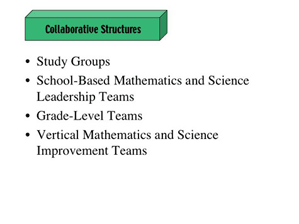 |
The next building block is collaborative structure. These are the times and the places for groups to come together to do their work. I want to be clear that the structures have to rest on the foundation of culture, because if we create structures without culture, then folks come together and talk about matters that aren't at the center of teaching and learning, like discipline or hats in school or chewing gum. I know that many of you are creating structures like these in your MSPs, like study groups, school-based mathematics and science leadership teams, grade level teams, vertical teams. I'd love to hear in our discussion how you're using these structures and what a difference they're making. |
| |
|
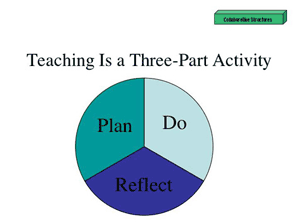 |
Collaborative structures are based on the assumption that teaching is a three-part activity, that it involves planning, doing, and reflecting. And typically, the way schools have been structured is to allow time only for the "do" part. So if you're not doing you're not teaching. Powerful, effective schools create the time and place for teachers to do all of their work. Their planning, their reflecting, and their working together with their colleagues. |
| |
|
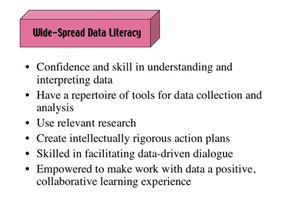 |
The next building block is widespread data literacy. This involves a shift from data as being a specialty of a certain group of people in this system, like maybe the research department or the assessment department, or a few central office staff or building principles, to everybody in the school community understanding how to use data. This includes being confident in the ability to understand data, make sense of it and interpret it appropriately. Knowing what you can learn from looking at fourth grade results in 2002 and a different group of fourth graders in 2003, and what you can't learn from that. Understanding when a small percentage change is significant and when it's not. A basic understanding of ideas like disaggregation, triangulation, the knowledge of statistics. A second feature of data literacy is having a repertoire of data tools, so you can conduct a root cause analysis, you can collect relevant data and make sense of it. You can display data in ways that are powerful. Data literacy also includes effective use of research, knowing when and how to access research and use it. To understand your problems better, to identify solutions. Another dimension of data literacy is the ability to talk to people about data, what we call data driven dialogue. This is a process of fence-making, being rigorous about separating your observations from the data to your interpretations of the data. So understanding that interpretations or inferences or assumptions require more data to test out. Data driven dialogue folks are clear that their assumptions are assumptions and not truth. I think with these dimensions of data literacy, school staff feel empowered to make data a positive and collaborative learning experience. |
| |
|
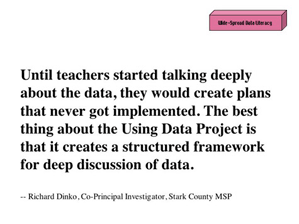 |
I like this quote from Richard Dinko, who's a coprincipal investigator at the Stark County MSP. And he says, "Until teachers started talking deeply about the data, they would create plans that never got implemented. The best thing about the using data project is that it creates a structure, framework, for deep discussion of data." |
| |
|
 |
So the final building block, and I think you'll agree that this is one of the biggest challenges, is timely access to useful data. Access really has two dimensions, one is that teachers are getting the data in time to respond to it, not after they're teaching a different group of kids, and that they data are democratically available, that there isn't, you know, some little place behind lock and key where the data sit, but teachers have access to which data that they need, disaggregated data, item level data. They are the folks in the school who can respond most to the data and they need to have it in their hands. Useful data goes far beyond the state assessments. Useful data includes multiple measures of student learning, multiple levels of student learning data, and other data sources, so let me talk briefly about these. |
| |
|
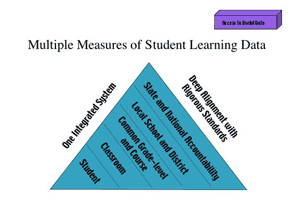 |
Multiple measures of student learning means that MSPs aren't relying just on those state assessments to guide their improvement, that there's an integrated data system that starts at the individual student level with longitudinal data, with diagnostic data, so that teachers can understand what each kid needs and how to respond to those needs. Rich and varied classroom assessments from the most informal kinds of observations, examining student work, to robust performance assessments, formative and summative. These kinds of data allow teachers to continually adjust their instruction to improve results. I'm getting really excited about the use of common grade level and course assessments, where teachers come together and decide on some common assessments to administer and then look at those results together and think together about how to improve instruction. School and district data assessments that align with the knowledge that the district is committed to, that provide some summative information about results, and then the state assessments and the national accountability results, so that there's an integrated system, we have lots of data along the way that's helping us understand how to improve so that we can then be accountable for our results. |
| |
|
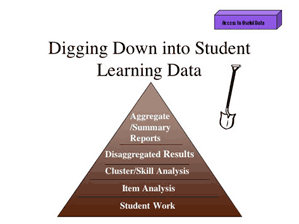 |
Not only are we concerned about multiple measures, but also multiple levels of the data, so that teachers are able to drill down deeply into the data to derive maximum value. That includes looking at the top level, kind of a superficial aggregate. But that's only the beginning of the conversation. Digging down and looking at disaggregated results, how subgroups are performing, digging down deeper to look at specific skills and clusters of skills, what are the strengths and weaknesses, digging down even deeper to look at patterns around items. Which items are kids missing a lot and why, and then grounding all of this analysis in careful examination of student work, which I think provides the richest source of understanding of kids' thinking. |
| |
|
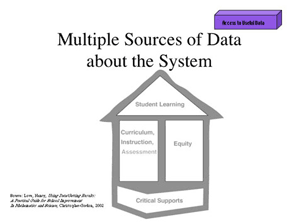 |
In addition to the multiple levels and the multiple measures, we need other kinds of data that help us understand what's going on in the system, so that we know what might be producing the results that we want to improve. These include data like observations about instruction, curriculum maps, surveys about teachers' perceptions of their curriculum instruction and assessment processes. Data that gives an insight into what's going into equity and access issues, like enrollment data, dropout data, interviews with students, data that give us a window into policies, leadership practices, and other dimensions of the system that need to be carefully examined. |
| |
|
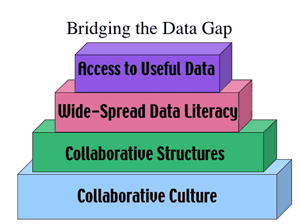 |
So, we've talked about four different building blocks, blocks that can help us bridge that data divide, collaborative culture, collaborative structures, widespread data literacy, and access to useful data. |
| |
|
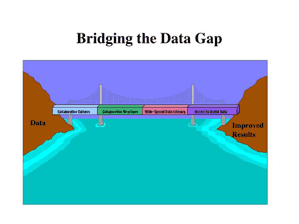 |
I think that with these building blocks, MSPs can be well prepared to bridge that data gap and to get excited about data and feel more empowered to be able to use data as the catalyst and guide to improving the teaching and learning of science, that I know you're all committed to. |
| |
|
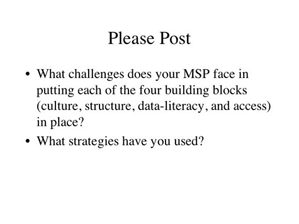 |
So, as you think about these issues, I'd love to hear from you about the challenges that you face in building these building blocks, about the successes that you've had, about the strategies that you're using. So please get online and share with us some of your thinking. Let's get started. |
A transcript of this presentation is available as well.


